Perga
Perga or Perge (Greek: Πέργη Perge, Turkish: Perge) was an ancient Greek city in Anatolia,[1] once the capital of Pamphylia Secunda, now in Antalya Province on the southwestern Mediterranean coast of Turkey. Today, it is a large site of ancient ruins 15 kilometres (9.3 mi) east of Antalya on the coastal plain. An acropolis located there dates back to the Bronze Age.[2]
Πέργη (in Ancient Greek) Perge (in Turkish) | |
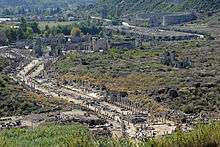 Overview of Perga | |
 Shown within Turkey | |
| Location | Aksu, Antalya Province, Turkey |
|---|---|
| Region | Pamphylia |
| Coordinates | 36°57′41″N 30°51′14″E |
| Type | Settlement |
| History | |
| Founded | By 1209 BC |
| Periods | Greek Dark Ages to Middle Ages |
| Cultures | Greek, Roman, Byzantine, Turkish |
| Associated with | Apollonius |
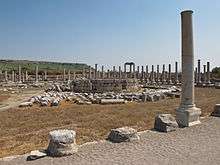
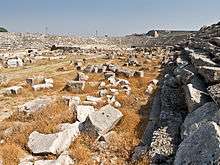
History
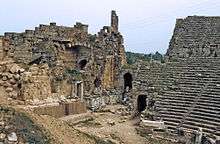
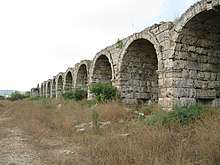
Perga was an ancient and important city of Pamphylia, between the rivers Catarrhactes and Cestrus (Turkish Aksu Çayı).[3][4]
A treaty between the Hittite Great King Tudhaliya IV and his vassal, the king of Tarhuntassa, defined the latter's western border at the city "Parha" and the "Kastaraya River".[5] The river is assumed to be the classical Cestrus. West of Parha were the "Lukka Lands".[6] Parha likely spoke a late Luwian dialect like Lycian and that of the neo-Hittite kingdoms.
Perge returns to history as a Pamphylian Greek city, and with Pamphylia came under successive rule by Persians, Athenians, and Persians again. Alexander the Great, after quitting Phaselis, occupied Perge with a part of his army. The road between these two towns is described as long and difficult.[7][4] Alexander's rule was followed by the Diadochi empire of the Seleucids, then the Romans.
Perge gained renown for the worship of Artemis, whose temple stood on a hill outside the town, and in whose honour annual festivals were celebrated.[8][4] The coins of Perge represent both the goddess and her temple.[4]
In 46 A.D., according to the Acts of the Apostles, St. Paul journeyed to Perga, from there continued on to Antiocheia in Pisidia, then returned to Perga where he preached the word of God (Acts 14:25). Then he left the city and went to Attaleia.[9]
As the Cestrus silted up over the late Roman era, Perga declined as a secular city.[10] In the first half of the 4th century, during the reign of Constantine the Great (324-337), Perga became an important centre of Christianity, which soon became the official religion of the Roman Empire. The city retained its status as a Christian centre in the 5th and 6th centuries.
Ecclesiastical history
St. Paul the Apostle and his, companion St. Barnabas, twice visited Perga as recorded in the biblical book, the Acts of the Apostles,[11] during their first missionary journey, where they "preached the word"[12] before heading for and sailing from Attalia (modern-day Antalya city), 15 kilometres (9.3 mi) to the southwest, to Antioch.
Paul and Barnabas came to Perge during their first missionary journey, but probably stayed there only a short time, and do not seem to have preached there;[13][14] it was there that John Mark left Paul to return to Jerusalem. On his return from Pisidia, Paul preached at Perge.[15][14]
St. Matrona of Perge of the 6th century was a female saint known for temporarily cross-dressing to avoid her abusive husband.[16] She also is known for opposing the Monophysite policy of the emperor Anastasios I.[17] Matrona hid in the monastery of St. Bassion as the enuch Babylos. Once revealed, she was sent to a woman’s monastery where she was head of the convent. She was famous for her miraculous gift of healing. She went on to found a nunnery in Constantinople. St Matrona died at the age of 100. Her life was told through a vita prima whose author and exact time period remains a mystery.[18]
The Greek Notitiae episcopatuum mentions the city as metropolis of Pamphylia Secunda until the 13th century. Le Quien gives the names of 11 of its bishops:[19] Epidaurus, present at the Council of Ancyra in 312; Callicles at the First Council of Nicaea in 325; Berenianus, at Constantinople (426); Epiphanius at the Second Council of Ephesus (449), at the First Council of Chalcedon (451),[20] and a signatory of the letter from the bishops of the province to Emperor Leo (458); Hilarianus, at a council at Constantinople in 536; Eulogius, at the Second Council of Constantinople in 553; Apergius, condemned as a Monothelite at the Third Council of Constantinople in 680; John, at the Trullan council in 692; Sisinnius Pastillas about 754 (an iconoclast who was condemned at the Second Council of Nicaea in 787); Constans, at the same council of that condemned his predecessor; John, at the Council of Constantinople of 869–70.[14]
No longer a residential, the bishopric is included in the Catholic Church's list of titular sees.[21]
Perga remained inhabited until the foundation of the Seljuk Empire, roughly 1000 CE.[10]
Notables
- Perga's most celebrated ancient inhabitant, the mathematician Apollonius (c.262 BC – c.190 BC), lived and worked there. He wrote a series of eight books describing a family of curves known as conic sections, comprising the circle, ellipse, parabola, and hyperbola.[22]
Archaeology
Perga is today an archaeological site and a tourist attraction. There were numerous excavations and discoveries since 1946.[23] Ancient Perge, one of the chief cities of Pamphylia, was situated between the Rivers Catarrhactes (Düden Nehri) and Cestrus (Aksu), 60 stadia (about 11.1 kilometres (6.9 mi)) from the mouth of the latter; the site is in the modern Turkish village of Murtana on the Suridjik sou, a tributary of the Cestrus, formerly in the Ottoman vilayet of Konya. Its ruins include a theatre, a palaestra, a temple of Artemis and two churches. The temple of Artemis was located outside the town.[14] Many of the coins struck in the city portrayed both the goddess and her sanctuary.[24]
Another big ancient city in the area is Selge, Pisidia, located about 20km to the northeast.
The Perge has been dubbed as “Turkey’s second Zeugma” for the alluring appearance of the mosaics that have been unearthed so far. In 2003, archaeologists discovered well-preserved Greek mosaics showcasing Oceanus and Medusa. In 2017, discovered a mosaic depicting the sacrifice of Iphigenia.[23][24]
A 1,700-year-old full-body statue of a dressed female with her broken head from the Hellenistic period were revealed by archaeologists headed by Sedef Cokay Kepçe in July in 2020. The statue, believed to have been built during the Roman Empire, will be on display at the Antalya Museum.[25][26]
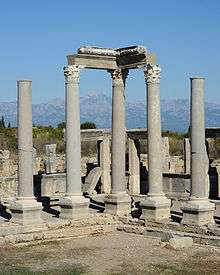 Pillars of the agora
Pillars of the agora Perge theatre
Perge theatre Perge theatre skene
Perge theatre skene Perge theatre skene
Perge theatre skene Perge theatre skene
Perge theatre skene Palaestra in front of the Roman baths
Palaestra in front of the Roman baths Caldarium in the Roman baths
Caldarium in the Roman baths Hellenistic city gate
Hellenistic city gate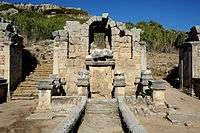
 Perge Towards West Gate
Perge Towards West Gate Perge Necropolis beyond West Gate
Perge Necropolis beyond West Gate Perge Necropolis beyond West Gate
Perge Necropolis beyond West Gate Perge Necropolis beyond West Gate
Perge Necropolis beyond West Gate
See also
Notes
- Hannah M. Cotton; Robert G. Hoyland; Jonathan J. Price; David J. Wasserstein (3 September 2009). From Hellenism to Islam: Cultural and Linguistic Change in the Roman Near East. Cambridge University Press. ISBN 978-0-521-87581-3.
- "Perge". Retrieved 2006-10-30.
- Strab. xiv. p. 667; Plin. v. 26; Pomp. Mel. i. 14; Ptol. v. 5. § 7.
-

- G. Beckman (1996). Hittite diplomatic texts. Atlanta., no. 18C
- J. David Hawkins (2009). "The Arzawa letters in recent perspective". British Museum Studies in Ancient Egypt and Sudan. 14: 73–83., 75
- Arrian, Anab. i. 26; comp. Polyb. v. 72, xxii. 25; Liv. xxxviii. 37.
- Strab. xiv. p. 667; Callim. Hymn. in Dian. 187; Scylax, p. 39; Dionys. Per. 854.
- Acts 14:25
- "Perge".
- Acts 13:13–14 and 14:25.
- Acts 14:25
- Acts 13:13.
-

- Acts 14:24.
- Talbot, Alice-Mary. "Holy Women of Byzantium: Ten saints lives' in English translation" (PDF). doaks.org. Dumbarton Oaks Research Library and Collection. Archived from the original (PDF) on 13 May 2014. Retrieved 19 November 2014.
- vita prima
- Le Quien, Michel (1740). "Ecclesia Perges". Oriens Christianus, in quatuor Patriarchatus digestus: quo exhibentur ecclesiæ, patriarchæ, cæterique præsules totius Orientis. Tomus primus: tres magnas complectens diœceses Ponti, Asiæ & Thraciæ, Patriarchatui Constantinopolitano subjectas (in Latin). Paris: Ex Typographia Regia. cols. 1013–1016. OCLC 955922585.
- Richard Price, Michael Gaddis, The Acts of the Council of Chalcedon, Volume 1 (University of Liverpool Press, 2005)p94.
- Annuario Pontificio 2013 (Libreria Editrice Vaticana, 2013, ISBN 978-88-209-9070-1), p. 952
- Boyer, Carl B. (1991). "Apollonius of Perga". A History of Mathematics (Second ed.). John Wiley & Sons, Inc. pp. 156–157. ISBN 978-0-471-54397-8.
- 1,800-year-old mosaic found in ancient city of Perge
- A Bevy Of Greek Mythology-Depicting Mosaics Uncovered At The Ancient City Of Perga, Turkey
- "3rd-century statue unearthed in ancient city". Hürriyet Daily News. Retrieved 2020-07-29.
- "3rd-century statue unearthed in ancient Greek city of Perge". The Archaeology News Network. Retrieved 2020-07-29.
External links
| Wikimedia Commons has media related to Perge. |
Chisholm, Hugh, ed. (1911). . Encyclopædia Britannica (11th ed.). Cambridge University Press.


- Perge Guide and Photo Album
- Over 500 pictures including 2013 excavations
- Perge photo